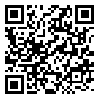BibTeX | RIS | EndNote | Medlars | ProCite | Reference Manager | RefWorks
Send citation to:
URL: http://ijn.iums.ac.ir/article-1-709-en.html
Background and Aim : Patients are among the most vulnerable social groups whose particular situation makes their rights more sensitive in health care system. They relegate themselves totally to the health care system and trust to the health professionals. In such a context, it seems necessary to provide tools and strategies for assuring patients rights advocacy. To designe and establish these tools, participation of all stakeholders is important and crucial according to WHO recommendations. The first step in this direction is entering to the world of the particular groups involving in patients’ rights practice in their daily activities and hearing their voices. The aim of this study was to explore lived experiences of patients, patients’ companions, nurses and physicians about patient’s rights practice.
Material and Method : This is a phenomenological study based on Van Mannen’s approach to investigate a shared experience from different perspectives. Data was gathered via semi-structured interviews with 9 patients, 3 patient’s companions, 8 nurses and 5 physicians in a central teaching hospital in Tehran, Iran. The transcribed interviews were analyzed through Van Mannen’s thematic analysis.
Results: Holistic care, awareness of rights, adequacy of resources, accountability and integrated rights of patients and health care providers were the main themes emerging in this study.
Conclusion: The findings of this study can reflect the meaning of patients’ rights practice from the lived experiences of patients, patients’ companions, nurses and physicians. This can be in use for the policy makers interested in considering their main partners perspectives when revising patients’ rights monitoring toolsReceived: 2010/02/7 | Accepted: 2014/08/25 | Published: 2014/08/25
| Rights and permissions | |
 |
This work is licensed under a Creative Commons Attribution-NonCommercial 4.0 International License. |




